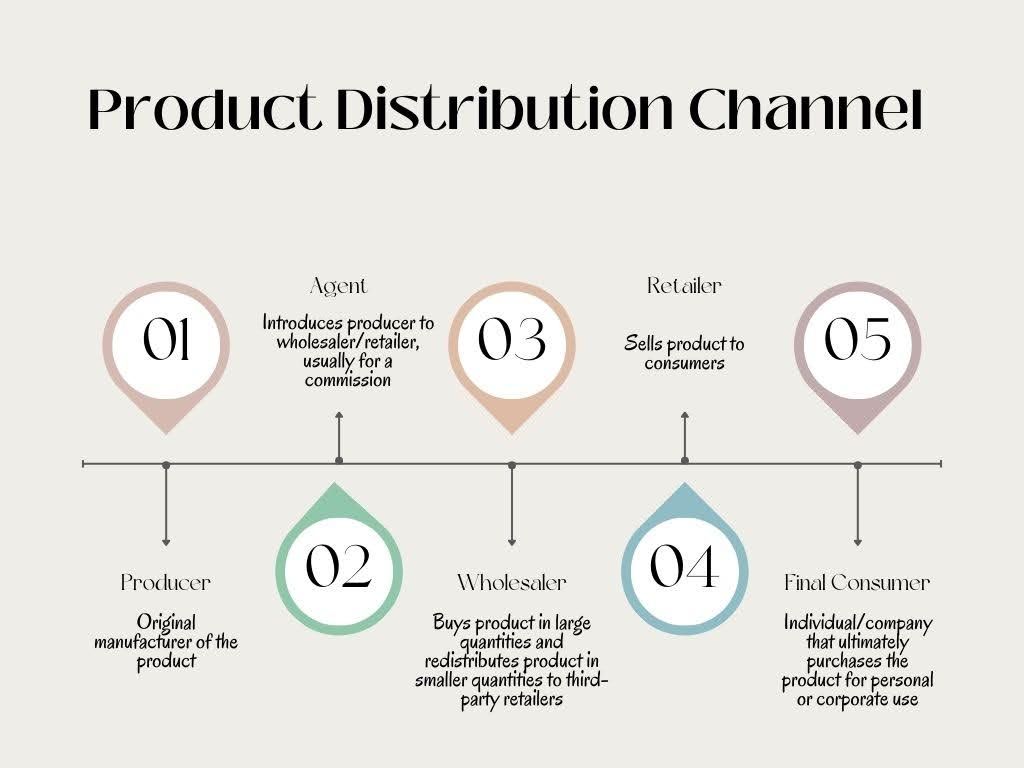What Are Product Distribution Channels?
The basic definition of a product distribution channel is the journey a product takes from distributor to consumer, according to Investopedia. While this seems like a fairly simple concept, the ways that manufacturers get their goods to their audience differ greatly in complexity and directness.
3 Types of Product Distribution Channels
There are three main types of product distribution channels that encompass the ways that products reach their final destination: direct, indirect, and hybrid channels. A direct channel is the simplest of the three, and it is as the name implies: the product goes directly from the producer to consumer. This often takes the form of a retail website or brick-and-mortar store owned by the producer itself. For example, if a ceramicist owns a pottery store where they sell their work to consumers, that is an example of a direct distribution channel. The producer is also the seller, with no intermediaries.
An indirect channel is a way of distributing products through third-parties that is not directly connected to the producer. Sales Force, an e-commerce software company, explains that these third parties can range from consultants to wholesalers to “value added retailers” (VARs.) These positions can play different roles in the product distribution channel. According to Indeed, “a wholesaler is someone who buys goods or products in large quantities from manufacturers or distributors and then resells them to retailers, other businesses or sometimes directly to consumers.” A consultant in this context is also someone who connects the producer with a secondary retailer. Unlike wholesalers, a consultant isn’t buying and selling large quantities of the product, instead they’re just acting as a bridge for communication between the original manufacturer and the secondary retailer. Sometimes a smaller producer won’t have the resources to connect with larger retailers on their own, so a consultant serves as a middleman to help get a product into large retail stores. VARs, on the other hand, actually contribute to the development of the product while also being crucial to the distribution, as they modify or enhance the product that they then sell to the consumers. According to Investopedia, VARs are particularly common in the tech industry, in which they are “expected to have a thorough knowledge of the product to properly customize, install, test, and maintain for the customer.”
An example of a well-known VAR is Verizon. You could walk into a Verizon store and purchase an Apple iPhone and an LG television, along with a Verizon wifi network and cable for your home, which would make the phone and the TV usable. Verizon sells features that enhance other companies’ products.
A hybrid distribution channel is a combination of indirect and direct distribution methods. In this case, the producer will have its own retail location through which they sell directly to consumers, (whether physical or online) as well as selling through third parties. An example of a third party retailer is a large store that sells many different brands, such as Target. If you wanted to buy a bar of Dove soap, you could do so from the website itself, or you could go to Target and buy it there. Therefore, the Dove brand is an example of a hybrid distribution channel as they sell their own products directly as well as selling through larger retailers such as Target.
Primary Factors in a Product Distribution Channel
There are five main roles in the distribution of a product: the producer, the agent, the wholesaler, the retailer, and the final consumer—in that order. The chart below illustrates the route that a product takes from producer to consumer. The only situation where a product will not go through all five steps is if the producer sells directly to the consumer through their own website or physical retail location. Indirect and hybrid distribution channels will typically use all five of the steps below.

Template by Rizelle Anne Galvez on Canva. Chart by Callie Leff.
An example of a company that follows these steps in their distribution channel is Coca Cola. According to the Coca Cola website, their company “manufactures and sells concentrates, beverage bases and syrups to bottling operations.” These third party bottling operations (which in this case replace the agent/broker role) bottle the finished product to sell to wholesalers/retailers, such as Golden Eagle Distributors, a wholesaler that distributes Coca Cola products. Golden Eagle Distributors or any other wholesaler then sells Coca Cola products in bulk to a large variety of retailers, which is ultimately how the product gets into the consumer’s hands.
In addition to the five core “players” in a product distribution channel, there are also four different levels of complexity that product distribution channels can have, according to Investopedia. The definitions of these levels are as follows:
Level-0 Channel: A Level-0 Channel is when the producer sells directly to the consumer, skipping all of the intermediaries in the middle, which is an example of a direct distribution channel.
Level-1 Channel: A Level-1 Channel is when a producer sells to a retailer which then sells to the consumer, skipping the steps of an agent and wholesaler. A Level-1 Channel can be either an indirect or a hybrid channel, depending on whether or not the producer has its own retail location in addition to the outside retailer.
Level-2 Channel: A Level-2 Channel incorporates a wholesaler which distributes to the retailer as an intermediary between the producer and the retailer.
Level-3 Channel: A Level-3 Channel adds in the presence of an agent or broker, following all of the steps on the chart above.
Both Level 2 and 3 channels can be either indirect or hybrid channels. Like a Level-1 Channel, their categorization depends on whether or not the producer has its own retail location as well as a third-party retailer.
Conclusion & More Resources:
For more information about developing a product and getting it into the hands of consumers, check out Pitch Labs articles “The importance of finding a niche market” and “What are factors that affect production?”

Leave a Reply